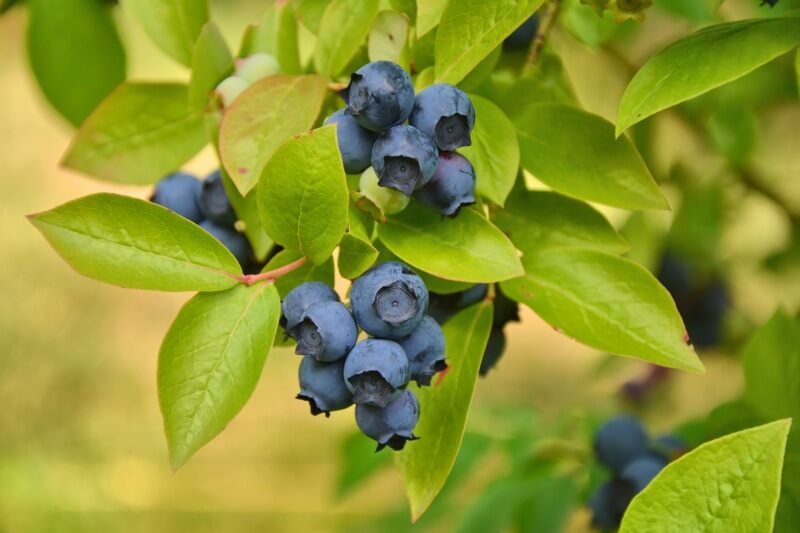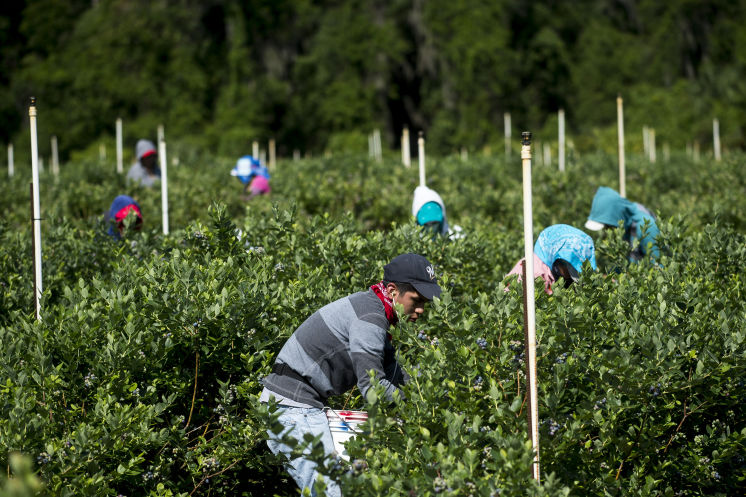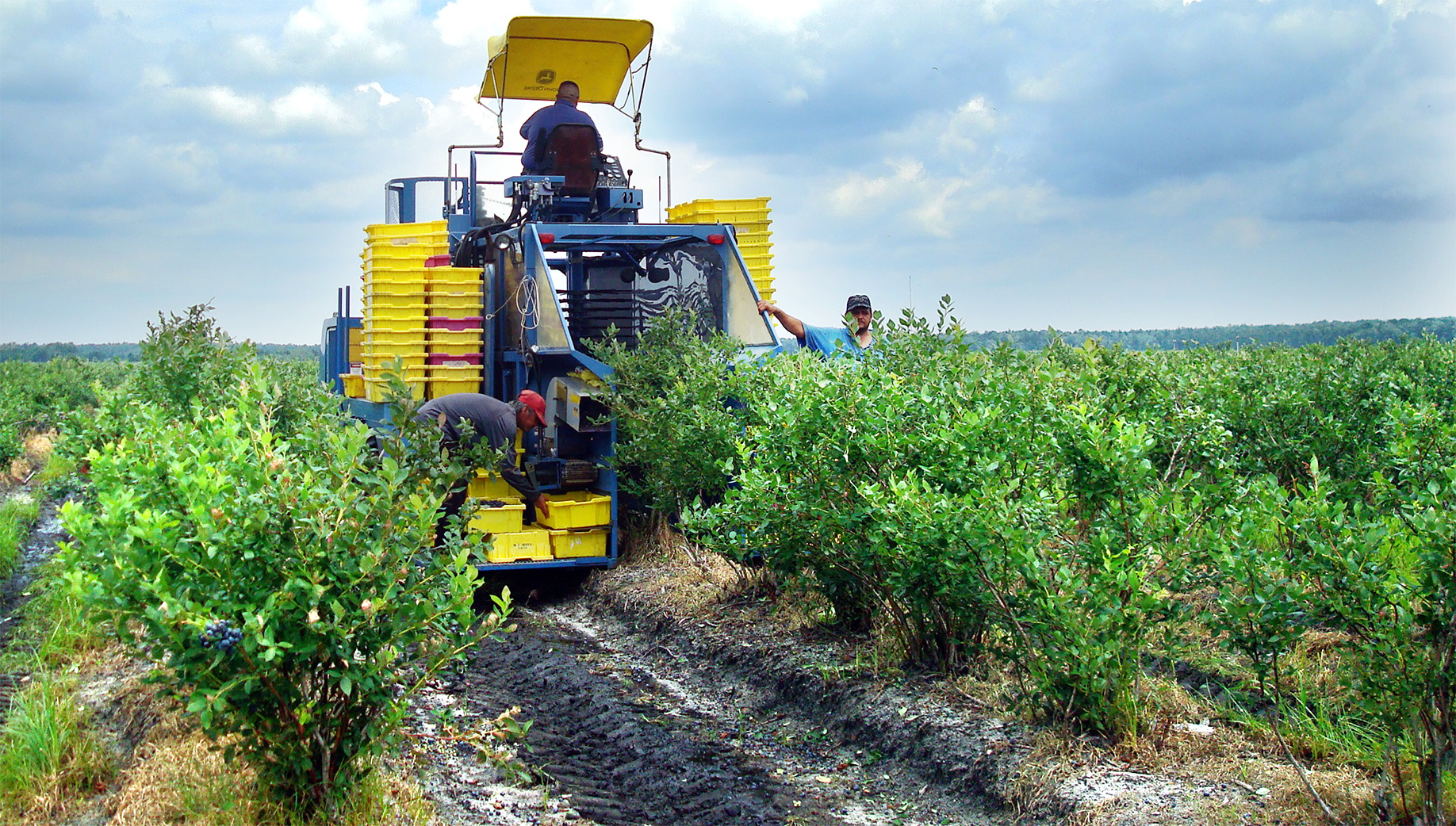Before choosing to grow blueberries, you need to determine which of the four types of blueberries is best suited for your region. All four types require a period of prolonged chilling to set flowers, but some need less time and cold than others. Planting different varieties of the same type will give you bigger berries and a larger yield.

The Right Varieties For Your Climate
- Highbush blueberries, the type usually found in supermarkets, are so named because the large, dark berries are borne on bushes that grow six to eight feet high. Popular northern varieties include Blueray, Bluecrop, Jersey, and Patriot. Southern highbush types, which thrive in zones 7-10, include Cape Fear, Gulfcoast, O’Neal, and Blue Ridge (V. pallidium). With a low chilling requirement, southern types bear well even in Florida.
- Lowbush blueberries are super-hardy, making them great for gardeners who live where winter temperatures regularly plummet below zeo. In contrast to tall high-bush varieties, ground-hugging low-bush stems grow a mere six to eighteen inches high as they spread by underground runners. The berries themselves are small and sweet, with a powdery, sky blue bloom. A few varieties of lowbush blueberries such as ‘Top Hat’ have been selected and bred, but wild seedlings simply called low bush blueberries are what are mostly available at nurseries. This means that fruit flavor and appearance, and plant size will vary from one seedling to the next.
- Half-high blueberries were born when growers married the large berry size of high-bush blueberries to the cold-hardiness of low-bush. The plants don’t grow as tall as high-bush, nor do they spread by underground runners. Varieties include Friendship, Polaris, Northland, and North-blue.
- Rabbiteye blueberries give southern gardeners another option besides southern high-bush. Typically smaller than high-bush berries, they ripen later in the season. Newer varieties, such as Bonita and Climax, have delectable flavor and cross-pollinate each other well. Rabbiteye bushes can grow ten or more feet tall, and the plants are less finicky about their soil than other kinds of blueberries.
Planting Them
So once you’re ready to plant them, for lowbush blueberries set them two feet apart, highbush blueberries six feet apart, and rabbiteyes fifteen feet apart. Enrich the soil in each planting hole by mixing in a bucketful of composted leaves or pine needles, which will help maintain acidity and provide a long-lasting source of humus for optimum nutrition, aeration, and moisture.
Right after planting, spread a three-inch layer of organic mulch over the ground. This mulch will thwart weeds and keep the roots cool and moist (most of a blueberry’s root system lies within inches of the soil surface).
Blueberries will grow in higher pH, but to achieve highest production, you will need to amend the soil around the plants. This can be done easily over time. Don’t try and reduce the pH all at once; a .5 per year reduction is ideal.

Lower your pH by using the following:
- Sawdust from any conifer (pine, spruce, fir). If you use sawdust, pay attention to Nitrogen; if leaves are yellowing, that indicates a Nitrogen deficiency.
- Ammonium Sulfate fertilizer
- Ground Sulfur fertilizer
Once the plants are settled into their new home, give them a thorough watering. Provide them with one to two inches of water weekly—from rain, a hose, or drip irrigation system during the growing season. Another way to measure water needs is to give them one-half to one gallon per square foot of root zone each week.
Soil and Sun
Blueberries will only grow well in soils that meet their needs:
• Soil must drain well. If water stands in the location you are planting for 2 days, don’t plant a blueberry.
• Blueberries grow best in acidic soils with a pH of 5.0
• Incorporating rich organic matter into the soil or as a top dress is ideal.
• If planting a row of blueberries (space plants 4-8 feet apart), consider “hilling” the plants; raise them above the natural soil level by 12-18″ high and 3′ wide. This improves drainage, and provides a row for constantly adding organic matter.
Once you have your location selected, make sure that the location will get full sun, at least ¾ of the day. Blueberries will tolerate partial shade, especially late in the day.
When to Plant Blueberries
Late winter or early spring, during the six weeks prior to your last spring frost, is the best time for planting blueberries. Young container-grown plants may be set out later but need time to grow roots before hot weather. Blueberries are only marginally self-fertile, so you’ll need to grow at least three plants of compatible varieties.
Growing and Pruning Blueberry Bushes
Pick off flowers that form on blueberry bushes their first year. Water new blueberry plantings during dry spells, and renew mulch as needed to maintain a 2-inch-deep layer. After plants are established, fertilize them in spring with a light application of a balanced organic fertilizer, or use an organic fertilizer labeled for acid-loving azaleas or hollies. Fertilize blueberries in late summer to help plants set plenty of flower buds.
Give blueberries watering priority during droughts. Blueberry bushes have extensive surface roots, so watch the wetting pattern of your watering equipment to ensure a thorough soaking to 6 inches deep.

Learning how to grow blueberries involves employing proper pruning technique and balancing new growth with old. Pruning is essential to keep production high, plants at a manageable height and berry size large. Healthy highbush blueberries and rabbiteyes should produce at least one new cane each year, but there may be more. In late winter, count the number of new canes and cut off an equal number of old ones at ground level. Cut back the tips of the new canes to encourage branching, and snip out dead branches and low limbs that would touch the ground if fruit-laden. If you don’t see any new canes, step up fertilization and check the soil pH.
Harvesting Blueberries
Blueberries taste best if they stay on the plant for a few days after they turn blue. Pick blueberries at least twice a week while they are ripe. Choose a mix of early- and late-maturing varieties to have fresh blueberries for more than a month.


